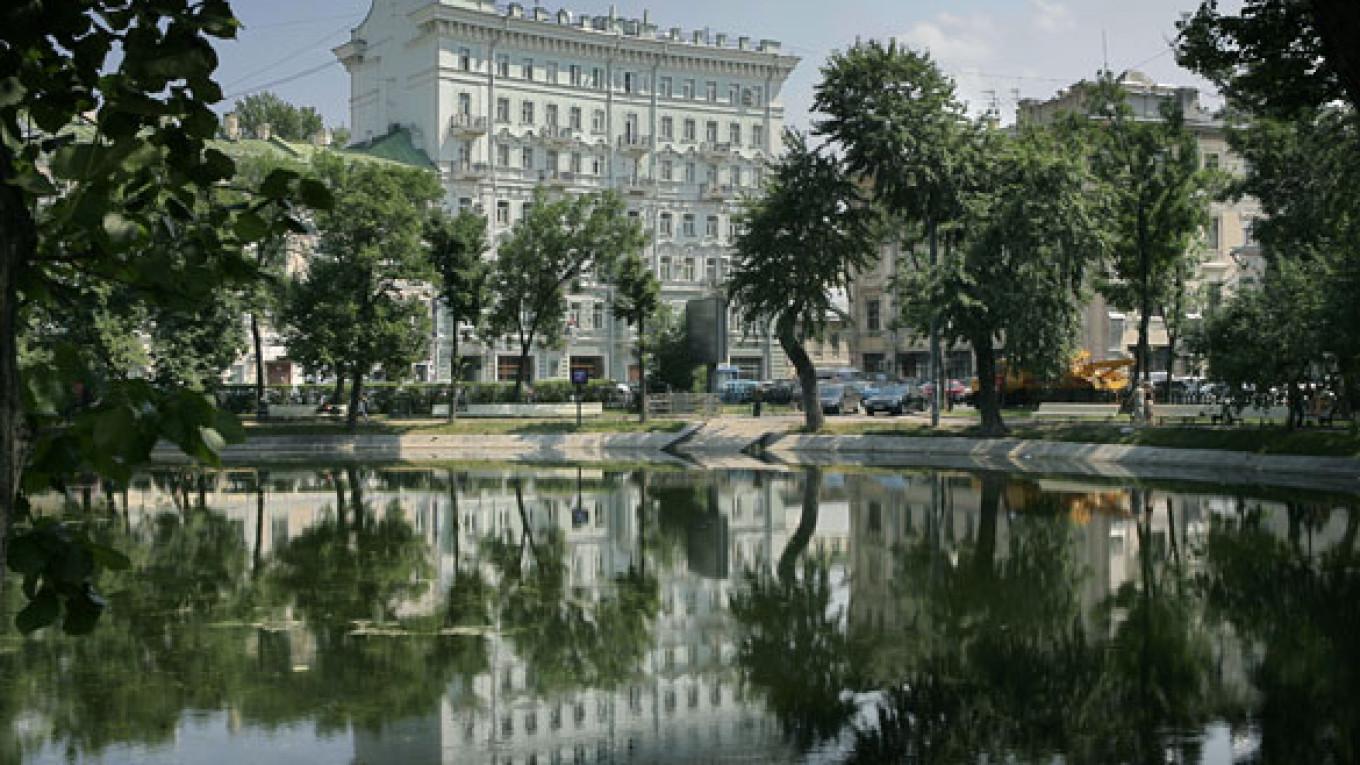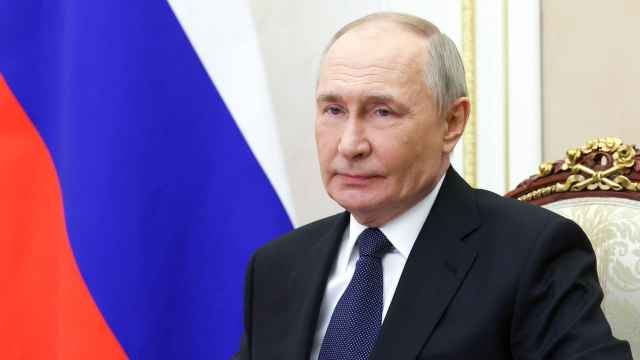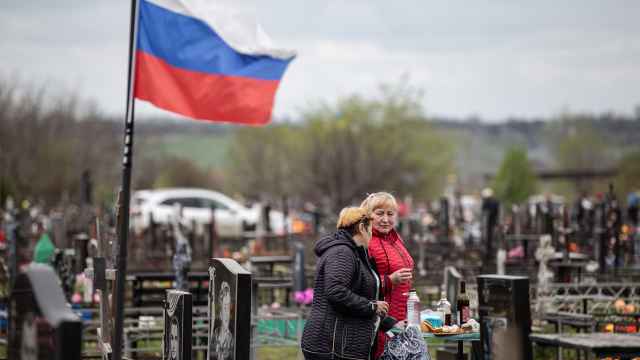If Ostozhenka is for fat cats and Arbat is for eclectics, then Chistiye Prudy is for nostalgics.
Although Chistiye Prudy — the area to the northeast of the Kremlin bounded roughly by Kitai Gorod and the Garden Ring — has become a center of nightlife, it also has managed to preserve its pre-Soviet architecture and layout better than similar central Moscow neighborhoods. In a city where skyscrapers are breaking through the low skyline, glass facades are replacing Soviet concrete and thoroughfares are being plastered and even spray-painted with advertising, Chistiye Prudy is one of the last places where homebuyers can still find the atmosphere of old Moscow.
“This area's still got lots of old buildings. It hasn't been reconstructed like other areas,” said Andrei Borodin, 33, who has lived in the neighborhood since 1991 and who works at Trans-Siberian Hostel on Barashevsky Pereulok. “You can still feel the Moscow we knew when we were children in the courtyards and lanes.”
Over the past decade, a real estate dichotomy has emerged in Chistiye Prudy. Because of its lack of construction and its proximity to centers of government, culture and business, it has a dual market: Spartan housing can be found in its mass of unrenovated rental apartments in old buildings, while luxurious living is on sale in its limited number of newly built or remodeled elite apartments. What's more, that gap is continuing even as new construction trickles into the neighborhood.
Unlike most of Moscow, Chistiye Prudy has remained relatively untouched since the late tsarist era. Its closest competitor for the “old Moscow” mantle, the Arbat neighborhood, was half torn-down in the Soviet period, but Chistiye Prudy weathered the ambitious reconstruction of Soviet times and the uninhibited development of the Wild '90s almost unscathed.
“The Chistiye Prudy neighborhood is unique in that substantial changes haven't happened since the end of the 19th century,” said Anastasia Mogilatova of the Welhome agency, which deals with elite real estate. “More than 50 percent of the buildings in this nook of old Moscow date to this time.”
Few mid-range alternatives exist between the area's elite and unrenovated options. Secondary market, or previously inhabited, apartments in the area have an average cost of 200,000 rubles to 230,000 rubles ($6,400 to $7,400) per square meter, realtors from the MIAN real-estate agency said. Meanwhile, Chistiye Prudy's new housing, most of which falls in the elite category, ranges from 250,000 rubles to 600,000 rubles ($8,100 to $19,300) or more per square meter. As the cost per square meter is multiplied, the price difference between old and new apartments becomes significant.
New construction will eventually come to the neighborhood simply because of the its central location, realtors said, though on a far smaller scale than in development hotbeds such as Ostozhenka, mostly because of the density and endurance of Chistiye Prudy's existing real estate.
Work and Play
The history of Chistiye Prudy, or “clean ponds,” starts with an “Unclean Pond,” or Pogany Prud, as the single pond remaining in the area was originally known. Although there are various accounts, it is commonly believed that the pond received the "unclean" name around the 17th century, when butcher shops on nearby Myasnitskaya Ulitsa would throw their meat scraps into the pond.
This and other nearby ponds became known as Chistiye Prudy around the turn of the 18th century, after a famous statesman and friend of Peter the Great, Alexander Menshikov, built a mansion in the area and cleaned up the ponds, according to Russian-language history web sites.
After Chistoprudny Boulevard was built in 1820, the Moscow upper class built mansions on the side of the thoroughfare closer to the Kremlin, while commoners built their homes on the outer side. Besides the various social classes, the area also was home to many religious and ethnic minorities.
Today, the traces of these enclaves can be seen in street names such as “Armenian Alley” and in the diversity of religious buildings, including Lutheran and Catholic churches and a synagogue. Today, a sizable number of French speakers can be found in Chistiye Prudy due in large part to the French Lyceum. Also, the Armenian, Belarussian, Iranian, Kazakh, Latvian and Swiss embassies are located here.
Many historic buildings dot the area, including the Sretensky Monastery (17th century), the Church of the Entry of the Holy Mother in Barashi (17th century) and the Church of the Archangel Gabriel (18th century). Alongside such architectural relics are Stalin-era apartment buildings and other monuments to Soviet architecture, including the Tsentrosoyuz Building. The best-known post-Soviet building is the red “Egg House” on Mashkova Ulitsa, which, as its name suggests, resembles a Fabergé egg.
Chistiye Prudy attracts homebuyers and renters not only with its historic architecture, but with its cultural life and closeness to the capital's centers of business and government as well.
“The assets of the cultural and historic center of the capital and the more business-focused, modern parts of the city are equally accessible” from the Basmanny and Krasnoselsky districts, said MIAN general director Vasily Mitko. Basmanny and Krasnoselsky are the two municipal districts in which the Chistiye Prudy neighborhood is located.
The combination of business and recreational features gives the area potential for long-term growth, Mitko added.
In particular, Mitko pointed out the proximity of the Higher School of Economics and various museums and government buildings, including the city and federal duma buildings. A large number of offices also has appeared in the area during the past 10 years. This has attracted many well-to-do tenants seeking to live within walking distance from work, he said.
Chistiye Prudy is less well-known as a place to work than as a place to play, however. Even during the Soviet era, Chistoprudny Bulvar was a street for strolling and socializing. Today, on any weekday evening or weekend with walkable weather, buskers play for change, young people carouse and passersby admire the boulevard's monuments. Recently, the boulevard hosted a temporary photo exhibit of Russian Orthodox religious scenes.
Since the fall of the Soviet Union, the area has witnessed an explosion of bars, 24-hour cafes and clubs, including Propaganda and Krizis Zhanra. Residents said the concentration of nightlife attracts young people from across the city.
“There's the boulevard and the clubs, or you can just walk around or go to a cafe,” said Darya Voskresenskaya, 27, who rents an apartment on Ulitsa Chaplygina. “Pokrovka is one of the best party streets in the city,” she added, referring to the street just south of the pond.
A final advantage of the region is its comprehensive public transportation infrastructure. The Red, Orange and Light Green subway lines converge in Chistiye Prudy, and buses, trams and marshrutki (gypsy vans) run frequently along the neighborhood's traffic arteries. Three trams travel along Chistoprudny Bulvar itself.
“The central location and developed transport infrastructure have especially influenced the character of the [Chistiye Prudy] real estate market,” Mitko said.
But Chistiye Prudy's main draw, realtors and residents agreed, is its peaceful, nostalgic atmosphere. The neighborhood's ambience even inspired an eponymous popular song by Igor Talkov, who sang “Chistiye Prudy, green dream of the centuries / the distant shore of my childhood / where the accordion plays.”
“Today Chistiye Prudy is the tranquility of cozy, quiet streets; an abundance of greenery, ponds and tennis courts; the famous theater, Sovremmenik; and ancient, low-standing residences,” Mogilatova explained. “This romantic atmosphere attracts buyers here.”
The Grass Isn't Always Greener
In addition to Chistiye Prudy's many attractive features, however, there are drawbacks. Despite Talkov's adulation of the region's “green dream,” Chistiye Prudy lacks a park of any significant size, and greenery is hard to come by outside the boulevard. The number of public schools lags behind that in central neighborhoods such as Khamovniki, realtors said, and exercise options are limited because of the lack of open space and relatively few fitness clubs.
“For people who like a morning jog, this is not the best place because of the air. There's lots of traffic, and there's no big park around here,” Borodin said.
Voskresenskaya also noted the poor air quality in the area. “The environmental conditions are bad, and there are constantly lots of people,” she said. “It suits me here, but if you have a child it's probably not healthy.”
On any weekday, the neighborhood's thoroughfares are overloaded. That poses the greatest inconvenience to those living or working in the area, realtors said.
“The discomforts are the same as in other central neighborhoods, especially transport access,” said Yekaterina Guriyeva, the head of the in-town residential real estate department at IntermarkSavills. “If you need to drive or take the kids somewhere, the situation is difficult, and Chistiye Prudy is not an exception.”
When asked about traffic in the area, Borodin was quick to relate anecdotes illustrating the daily — and sometimes nighttime — gridlock.
On weekends, he said, "there's horrible traffic jams even at three in the morning because of the big clubs." Even if you do manage to make it through the traffic, it is nearly impossible to find a spot for your car because of the underdeveloped parking, he added.
Parking is cropping up in other neighborhoods, but it isn't appearing in Chistiye Prudy, or at least not much of it, Guriyeva said.
Rising Demand
Nonetheless, demand for housing in Chistiye Prudy is growing, realtors said. While the neighborhood is not grouped with "The Golden Mile” of astronomically priced real estate near Ostozhenka, the average price per square meter of elite new real estate in Chistiye Prudy — about $15,000 — is the third-highest out of 11 centrally located neighborhoods, according to Welhome statistics.
The majority of new apartments for sale belong to the elite segment of the market, Mitko said. By MIAN's standards, “elite” signifies a price of at least 250,000 rubles ($8,100) per square meter, a videocamera security system, high-quality construction materials and an express elevator if in a multistory building.
The limited construction in Chistiye Prudy — most new buildings are raised next to an existing structure on the same plot of land — leads to high demand for new elite apartments. As a result, many buyers turn to the secondary market for elite homes. Mitko said most clients purchasing new real estate in Chistiye Prudy are wealthy buyers seeking elite apartments to live in or as an investment. Finding middle-class housing is difficult, he added.
An economical alternative to the elite market is housing in run-down older buildings, often without elevators, which is plentiful in Chistiye Prudy and costs less than similar housing in central neighborhoods like Khamovniki, Guriyeva said. In fact, the majority of real estate transactions in the neighborhood take place on the secondary market, said Mitko.
“Among our buyers on the secondary market are members of the upper middle class who work in large Russian and international companies or own small businesses,” he added.
Borodin, whose family lives in a six-room apartment in an older building, echoed Mitko's appraisal of the average Chistiye Prudy real estate buyer as upper middle class, noting that a foreign architect and a French diplomat live in his building. Voskresenskaya said apartment owners are mostly lifelong Muscovites and “intelligentsia,” while many middle-class and “artistic youth” rent apartments here.
Borodin lauded secondary market apartments in the area, pointing out that older apartments are often more spacious and feature higher ceilings. However, buyers should scrutinize the condition of older apartments and the building's utilities, since a lot of those on the market require major renovations, Mitko cautioned.
“If you rent an inexpensive apartment, it often happens that the conditions there are poor,” such as with plumbing, said Voskresenskaya, who has done renovations in her apartment in exchange for reduced rent.
Although elite new apartments are in vogue in Chistiye Prudy, supply has yet to catch up to demand. Construction of elite housing in the region began only in the early 2000s, much later than in Arbat, Ostozhenka and Patriarch's Ponds, realtors noted. Furthermore, new construction has been limited by the density of existing buildings in the area.
“Thanks to the landscape and historically developed architectural conception of the neighborhood ... massive construction of modern housing here isn't possible,” Mogilatova said.
One of the few major housing construction projects in the region is Dom na Myasnitskoi, which is being built on Myasnitskaya Ulitsa by Sobor-Sm with investment from the Moscow government. The five-story complex, which is slated for completion in fall 2012, is expected to have office and retail space on the first two floors. It also will have four additional levels underground, including three stories of parking.
Apartments start at 330,000 rubles ($10,600) per square meter, with the most expensive offering so far a 386 square-meter apartment for 235.8 million rubles ($7.6 million). Medium-size apartments of up to 150 square meters with views on Myasnitskaya and the city center are most in demand, said Mitko, who has clients considering apartments in the building.
More construction is on the way, realtors said. Although developers can construct elite housing in Chistiye Prudy with the knowledge that it will sell, for now it is simpler to build in other neighborhoods with fewer constrictions, Guriyeva said. But as the rest of Moscow is built up, developers will turn to Chistiye Prudy if only because of its central location.
Realtors are recommending Chistiye Prudy as a place to invest in real estate. “The purchase of housing in the area around Myasnitskaya Ulitsa was and remains attractive from the point of view of long-term investment,” Mitko said.
When development does arrive, it remains to be seen whether Chistiye Prudy will change drastically or remain a neighborhood for nostalgics.
A Message from The Moscow Times:
Dear readers,
We are facing unprecedented challenges. Russia's Prosecutor General's Office has designated The Moscow Times as an "undesirable" organization, criminalizing our work and putting our staff at risk of prosecution. This follows our earlier unjust labeling as a "foreign agent."
These actions are direct attempts to silence independent journalism in Russia. The authorities claim our work "discredits the decisions of the Russian leadership." We see things differently: we strive to provide accurate, unbiased reporting on Russia.
We, the journalists of The Moscow Times, refuse to be silenced. But to continue our work, we need your help.
Your support, no matter how small, makes a world of difference. If you can, please support us monthly starting from just $2. It's quick to set up, and every contribution makes a significant impact.
By supporting The Moscow Times, you're defending open, independent journalism in the face of repression. Thank you for standing with us.
Remind me later.






